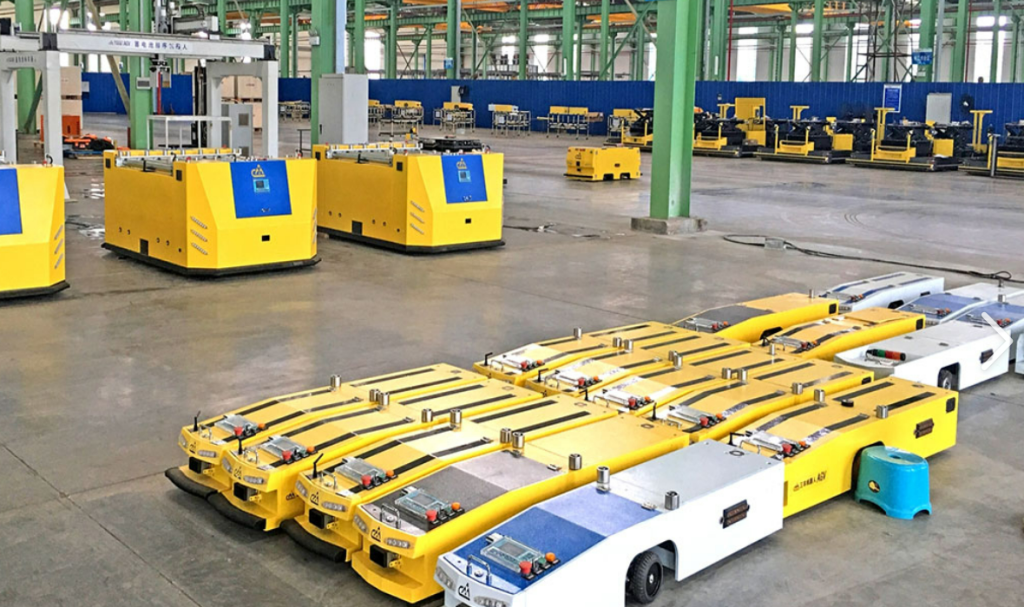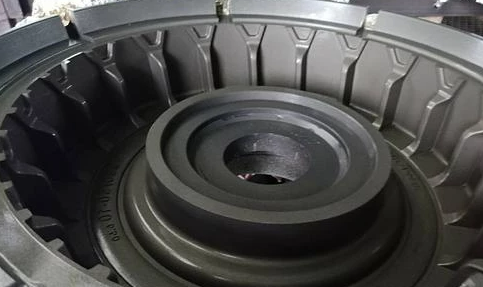
Modbus Industrial RFID Reader for AGV Positioning Management
The RFID AGV Vehicle Positioning/AGV Station Identification Application is designed to address the current need for path positioning and identification of AGV vehicles within industrial enterprises. This solution employs RFID identification technology integrated with an information software system.
RFID landmarks are pre-installed at key nodes along the AGV vehicle’s travel path to serve as positional identifiers for each station. An industrial RFID reader/writer is mounted on the AGV vehicle. As the AGV transports goods through the factory and passes each node, the RFID reader automatically captures the RFID landmark information and transmits it in real-time to the backend management system. The backend system identifies the node location information associated with the recognized RFID landmark ID and displays it within the software system.
The RFID industrial reader/writer features IP68 protection rating, making it suitable for various harsh industrial environments. It offers multiple communication interfaces, including RJ45, RS232, and RS485. Additionally, it supports the MODBUS bus protocol for direct communication with PLCs. The RFID ground marker tags also meet IP68 protection standards and can be customized according to specific on-site application environments.
1. Current Challenges in Pallet Management
*Manual data collection is required for pallet inventory counts, with each item recorded individually. Manual verification is also needed for inbound and outbound shipments, resulting in low efficiency.
*Pallets remain in a black box state during transportation, making their movement status unknown.
2.The Need for RFID Pallet Management
Rapidly conduct bulk inventory counts of pallets in stock;
Quickly identify pallet quantities during bulk inbound and outbound operations, cross-referencing with corresponding transaction records;
Capture pallet data at critical transportation checkpoints to monitor transport status;
RFID tags support long-term, reusable deployment.
Solutions provided to customer
Based on the issues encountered in the client’s current pallet management system and their project requirements, our company recommends using UHF RFID pallet tags to identify each pallet requiring management. During warehouse operations, RFID handheld terminals should be employed for inventory counting and location tracking. When pallets enter or exit the warehouse, fixed RFID readers should be used for rapid batch identification of incoming and outgoing pallets. For transportation monitoring, RFID reader/writer equipment should be deployed at each monitoring node along the transport route. Upon arrival at these locations, personnel will use RFID reader/writer terminals to capture data from pallets being loaded or unloaded. This data will be transmitted in real-time to the system via 3G/4G networks. The specific implementation plan is as follows:
- RFID tags embedded in pallets
Within the customer’s empty container management center warehouse, all pallets requiring management are equipped with a single UHF RFID tag. Operating at 860MHz-960MHz in the ultra-high frequency band, this tag delivers exceptional read performance exceeding 6 meters, enabling long-range automatic batch reading. Encased in high-strength engineering plastic, the tag is dustproof and waterproof, suitable for both indoor and outdoor environments.
Conventional UHF RFID tags exhibit weak anti-interference capabilities around metal objects, significantly impairing read efficiency when attached to metal pallets. Considering the diverse pallet types at the client’s site, this solution offers two options: standard pallet tags for non-metallic materials like plastic, and anti-metal pallet tags specifically engineered for metallic surfaces. This dual approach ensures high read rates in practical use.
Each pallet tag is uniquely bound to a specific pallet in the customer’s inventory, maintaining a one-tag-per-pallet relationship with a distinct tag ID. Given the pallets’ prolonged outdoor circulation, secure attachment is essential. We recommend affixing the RFID pallet tags to the pallet sides using rivets or screws for durability. - Batch inventory count in the pallet warehouse
To enhance inventory efficiency and quickly assess the stock status of pallets within the warehouse, our RFID pallet management solution recommends equipping warehouse personnel in the factory’s finished goods warehouse with RFID handheld terminals. These terminals feature built-in high-performance RFID read/write modules and antennas, operating on an Android system with a user-friendly interface for easy operation.
When conducting inventory checks, staff use the built-in pallet management app on the RFID handheld terminal to select the inventory function. By moving through the pallet storage areas within the warehouse, the terminal automatically captures pallet data within its coverage range. This data is then transmitted in real-time to the system via the Wi-Fi network. - Batch pallet entry and exit identification
Before pallets are dispatched from the empty container management center’s warehouse, each pallet is embedded with an RFID tag. To accurately capture all pallet entry and exit information, this solution requires installing corresponding reading devices at the warehouse entrances and exits requiring management. We recommend using a UHF RFID smart access control system. This access control device features a minimalist design, and the access lane width can be adjusted according to on-site requirements.
To prevent false reads, this access system employs an infrared beam-triggered mode. Its specially designed internal antenna narrows the radio frequency beam, minimizing unintended reads of non-pass-through pallets.
When a pallet equipped with an RFID tag passes through the access control channel, it first triggers the system’s built-in infrared sensors. These sensors activate the reader to capture the RFID tag entering the channel. The tag information is then transmitted via the reader to the host computer software for display.
Pallet Entry/Exit Determination: The system incorporates two sets of infrared triggers with distinct identifiers. Pallet entry/exit can be determined by the sequence of infrared trigger activations. For enhanced precision, the access control configuration can be expanded: a single-channel setup using two access points, or a dual-channel setup using three antenna groups. Assigning separate channels for warehouse entry and exit enables more accurate tracking of personnel movement. - Monitoring of Pallet Transport Circulation Processes
During pallet transportation, loading or unloading may occur at intermediate points. To accurately monitor these loading/unloading activities, we recommend equipping staff with RFID handheld terminals at key transportation nodes. When loading or unloading goods, personnel use the RFID handheld terminals to capture data. The RFID handheld terminals can be equipped with built-in 3G/4G mobile SIM cards. In cases where collection points along the transport route lack Wi-Fi coverage, data is transmitted to the backend system via the 3G/4G network.





